If reading about the people I've visited inspires you to help, you can donate to the Center for Farmworker Families. Every penny given goes directly to these families for clothes, shoes, food, school supplies, and more.
On the fifth day of our trip, we at last began to engage in the activity that was the real purpose of coming: going to rural villages, called "ranchos," outside of Cuquio to deliver aid and to learn about the lives of the people living there. We arranged to leave at 1pm and we spent the morning getting ready: purchasing and packing a pinata, purchasing about $15 of fruit (including an enormous watermelon - a huge treat for the kids in the village!), and a large cake.
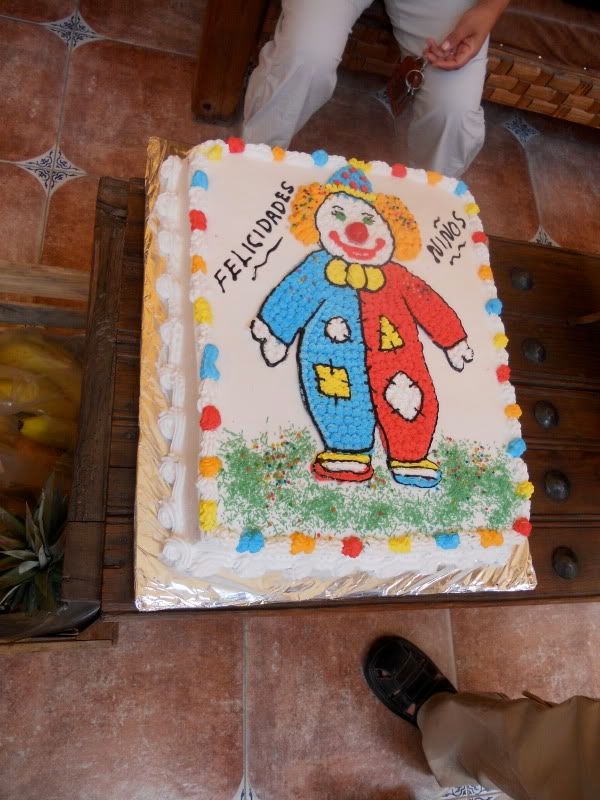
At 1pm, our ride appeared: a police pick-up truck, driven by a few Mexican policemen who were armed to the teeth with semi-automatic weapons. On the drive to Cuquio, the suitcases went in the truck and we rode in a van. This time, we piled 2 people and a cake into the front of the truck and 9 more plus a policeman into the back along with the pinata, two large suitcases, a watermelon, and a box of fruit. Then, off we went.
The drive to this rancho wasn't terribly long. Part of the road was newly paved, making the drive quicker than it would have otherwise been. In the past, it was all dirt. Now it was just mostly dirt.
Along the way, we frequently stopped, inviting anyone we passed to come to our party to enjoy our cake and our pinata. When we reached our destination, a crowd of kids were eagerly awaiting us. They chased our truck the last few meters to the house where we were visiting, excitedly shouting and giggling because they knew what was in store.
Ann Lopez, who goes by "Ana" here in Mexico, first visited this village a decade ago, after meeting a man from here in California, where he was working as a farmworker. He was the son of a woman I'll call Rosa, and he'd been in California so long (with no way to visit home regularly) that for years he never even met his youngest sisters. Today, we were visiting his mother, Rosa, her children, and her grandchildren. As we were promised, most of the residents of the village were children, women, and the elderly, with very few working age men around at all. There were quite a few young women, my age or younger, who already had children.
When we first got out of the truck, we found ourselves standing around awkwardly. After a round of handshaking and "mucho gustos" ("Nice to meet you"), we were left without much to do among a crowd of people we hardly knew. Someone asked "What are we waiting for?" Ann replied, "We're waiting for a rope to appear" and then added that somehow, magically, when we show up with a pinata, a rope always appears. Sure enough, someone brought out a rope, and then a few men from the village climbed on opposing sides of the roof to hang the pinata.

Rosa helping a child hit the pinata
The kids, some of whom had already snuck a peek at some of the toys poking out of the top of the pinata, huddled around, barely able to stand still with excitement. A few adults assembled them into a line with the littlest ones first. As each child took a turn hitting the pinata, the others sang the pinata song:
Dale, dale, dale,
no pierdas el tino;
Porque si lo pierdes
pierdes el camino.
Ya le diste una,
ya le diste dos;
Ya le diste tres,
y tu tiempo se acabó
Translation:
Hit it, hit it, hit it (literally "give it to it!")
Don't lose your aim
Because if you lose it (your aim)
You will lose the path.
You've already hit it once
You've already hit it twice
You've already hit it three times
And your time is over
It didn't take long for the entire pinata to burst open, spilling toys and sweets everywhere. The children fell on the ground, grabbing what they could: small stuffed animals, lollipops, dress up jewelry, action figures, and all sorts of other small toys that my stepkids in the U.S. have too many of and the kids here have none of.
After the pinata, the children lined up to receive the other goodies we brought them. Some of the kids told us they were embarrassed to go ask for what they wanted, and their parents would choose which shoes and clothes they would receive for them. Another boy complained that he didn't get a pair of soccer shoes like he wanted. A few women and children hung outside the gates of the house's courtyard. We found out that the father of that family had gotten in a physical fight with one of Rosa's sons, and relations between the two families were not good. We encouraged them to join us and take part in the fun. Any disagreement between the men did not need to extend to the women and children, and certainly not to our group of visiting Americans.
While they children (and adults) received their gifts, I wandered around taking pictures of the home and the farm. The house was a relatively small house, partially of adobe, partially of brick. We found out later that originally the house was just the adobe section and one of the sons earned the money to expand it when he went to America to be a farmworker for a year. They had no running water, and retrieved their water and bathed in a nearby stream. Until recently, they had a dirt floor. A government program was putting in cement floors for people with dirt floors, and they received their cement floor in the last year. Despite their small home and poverty, they still did their best to make their home beautiful, with flowers planted everywhere.
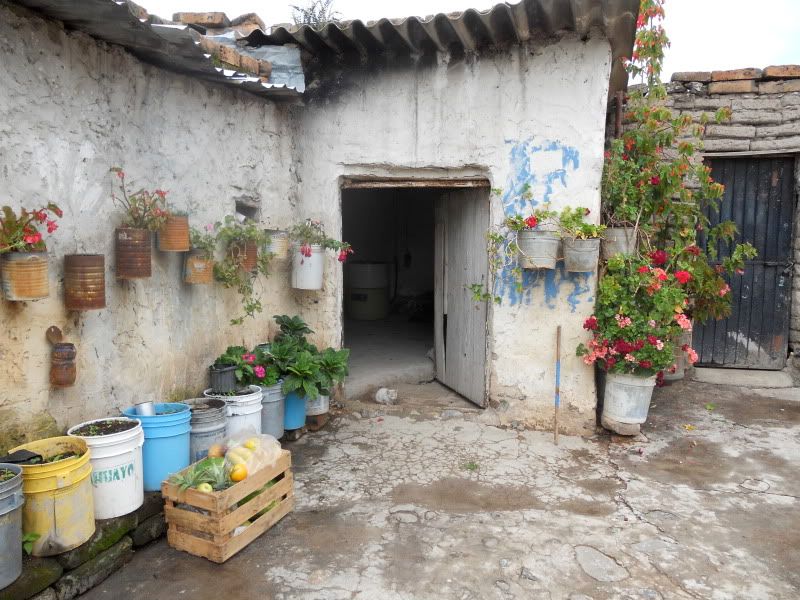
A view of the original adobe part of the house, taken from inside the courtyard
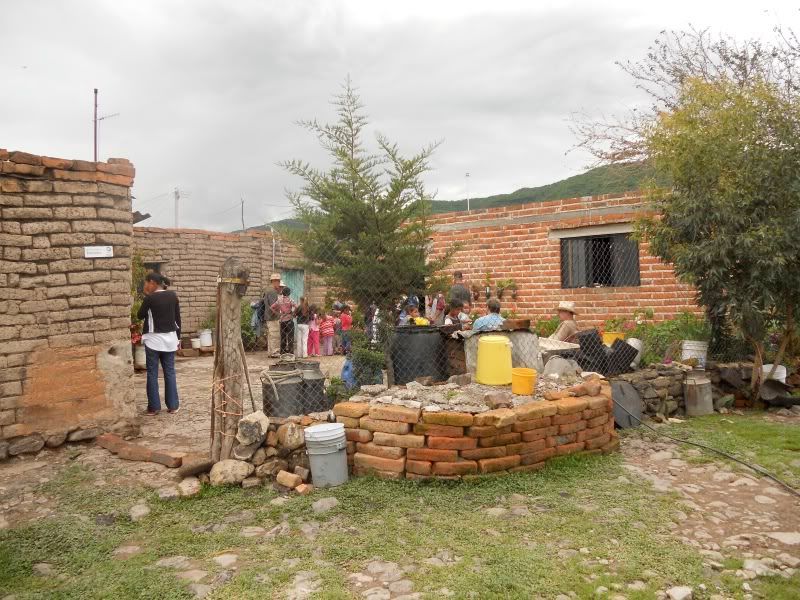
A view of the house from outside the courtyard
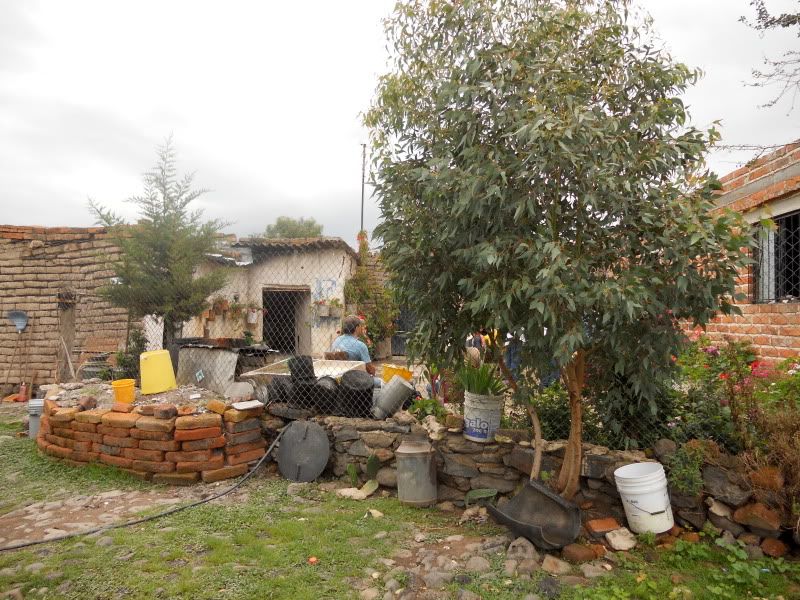
Another view from outside the courtyard
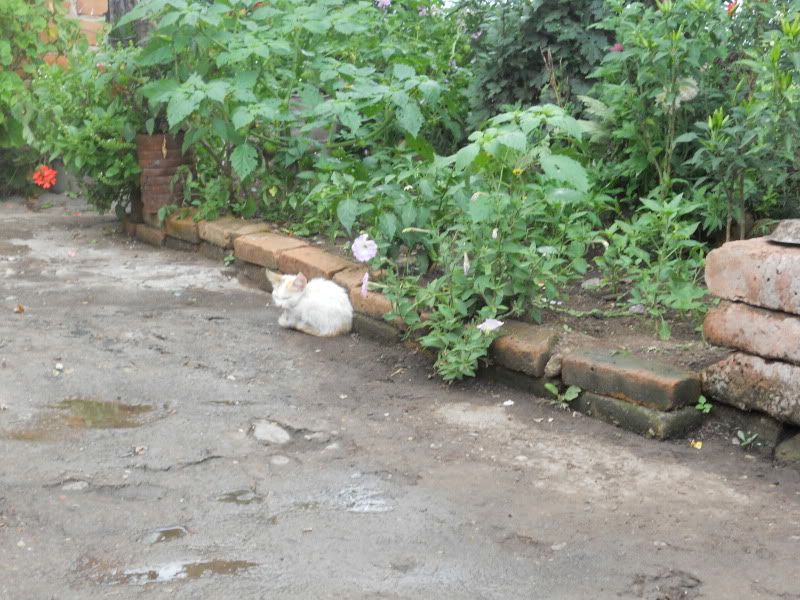
A kitten in the garden
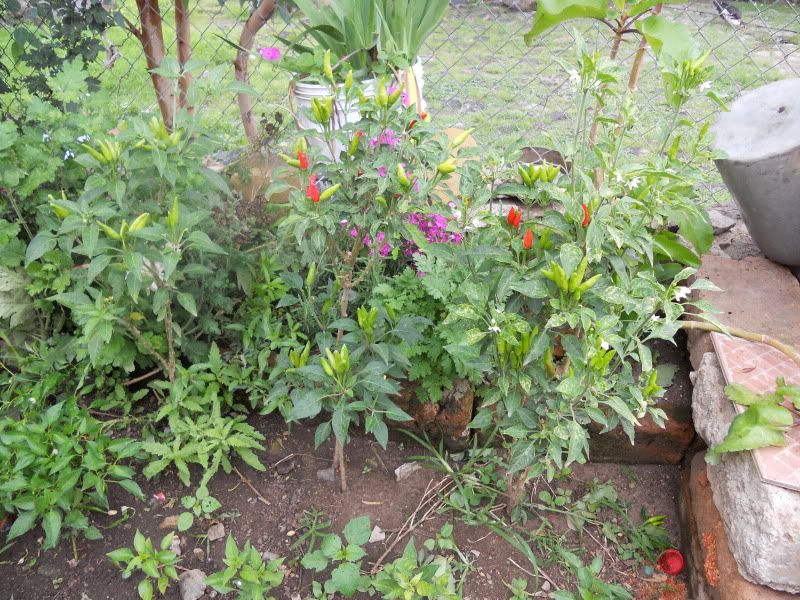
A close-up of the garden in the courtyard, where they grow chilis and basil
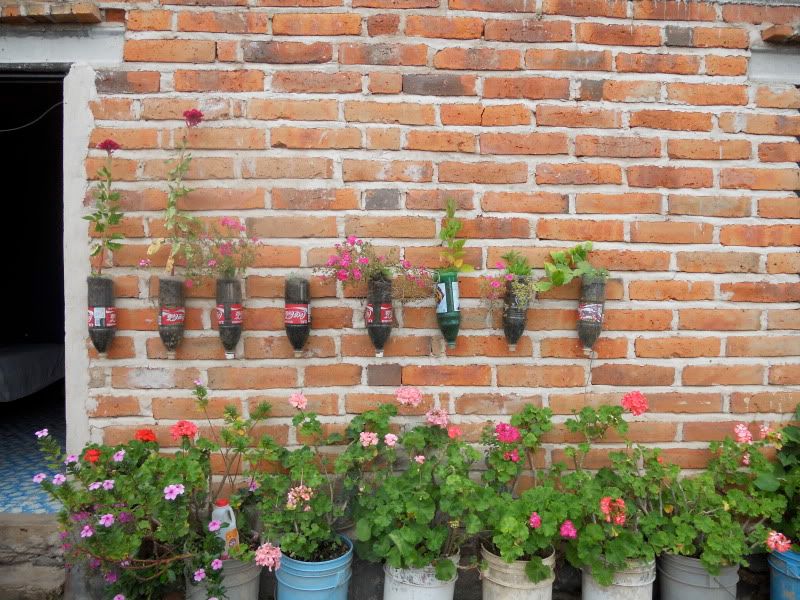
Flowers in Coke bottle flowerpots
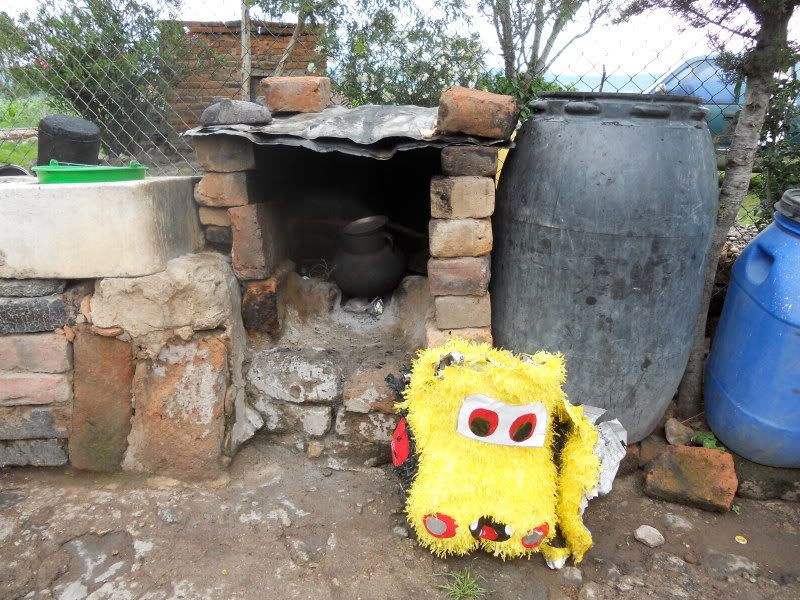
The remains of the pinata next to a cooking pot over a fireplace in the courtyard
On their small amount of land, they planted the traditional "three sisters" intercropped combination of corn, beans, and squash as well as tomatoes (planted separately). They had a rooster and several hens, a Muscovy duck, a turkey, a donkey, and several dogs and cats. They also had a mother pig and a litter of very young piglets, although I found out later that the pigs were property of Rosa's husband, an alcoholic who sold what he could of the family's land to buy booze and ultimately disappeared, showing up only when he wanted food. He either sold the piglets young or raised them and then sold them as slaughterweight pigs, using the money for more booze.
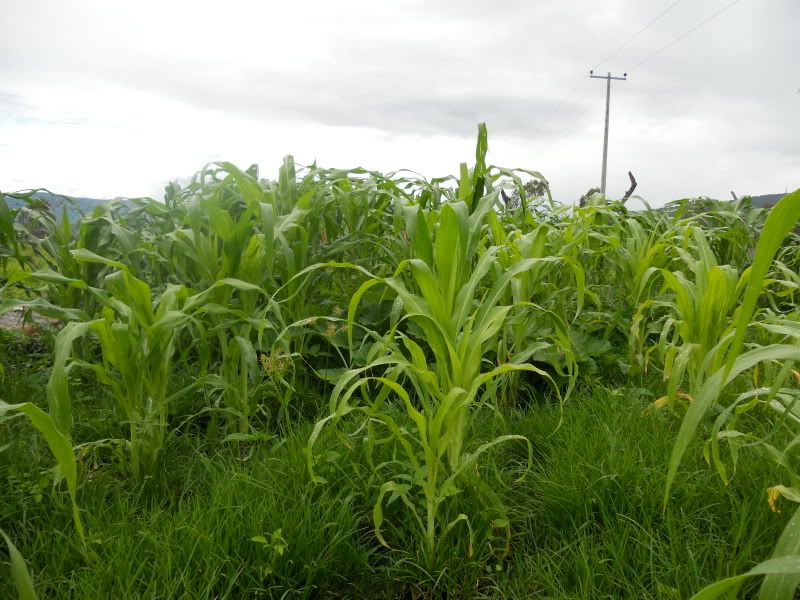
The milpa (cornfield), with corn, beans, and squash. Notice the ground is not bare.

Another view of the milpa
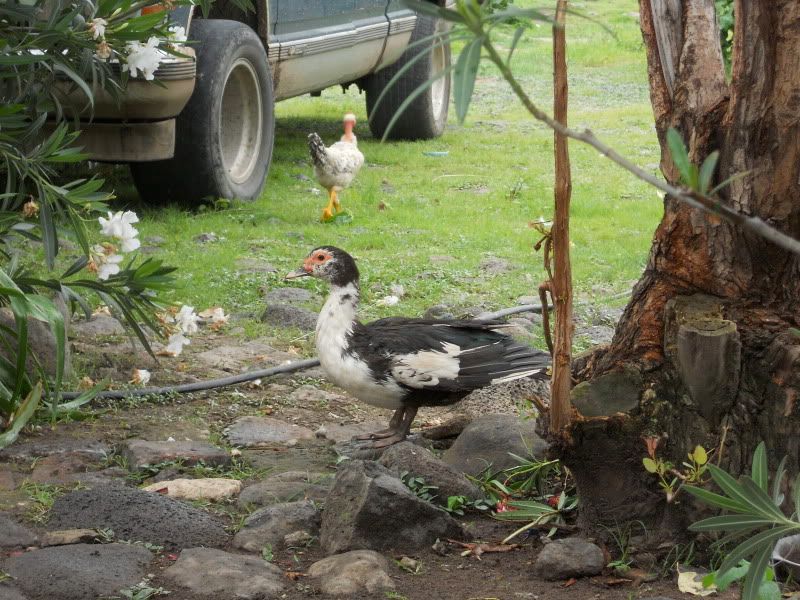
Muscovy Duck
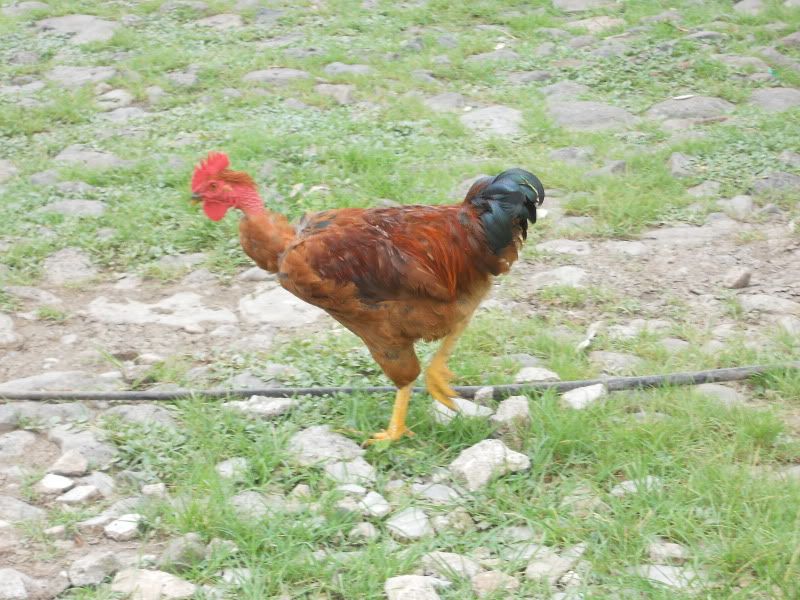
Rooster
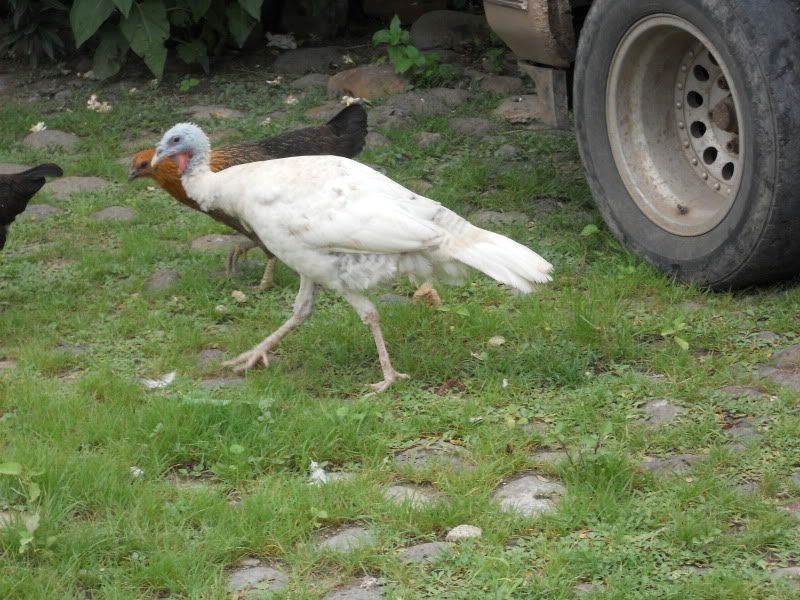
Turkey
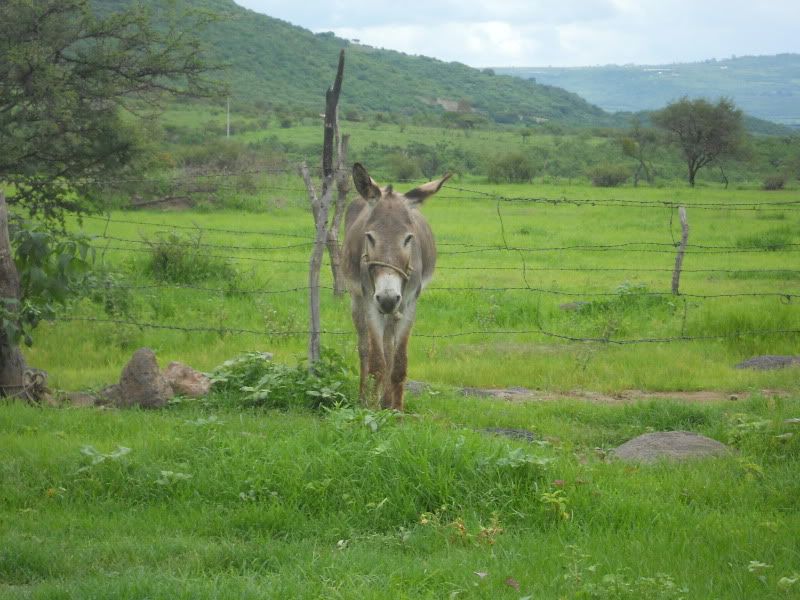
Donkey
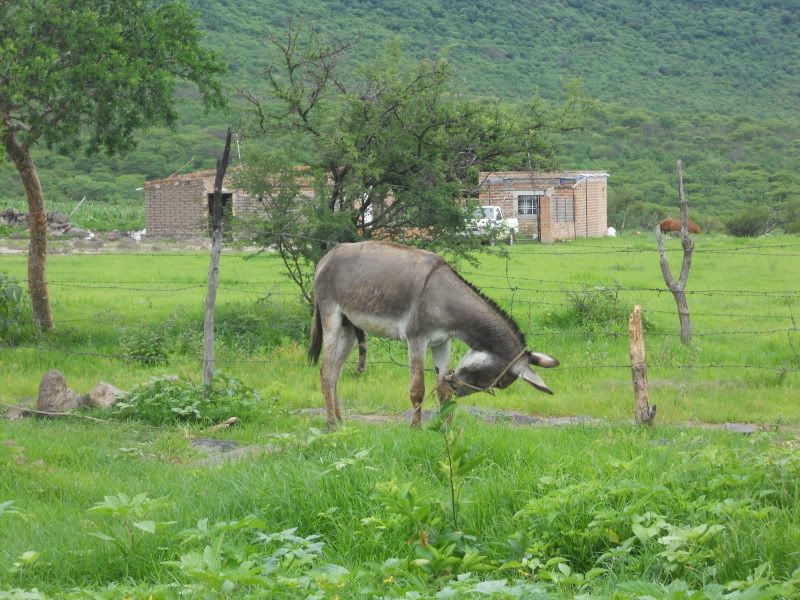
Donkey, checking out his equipment
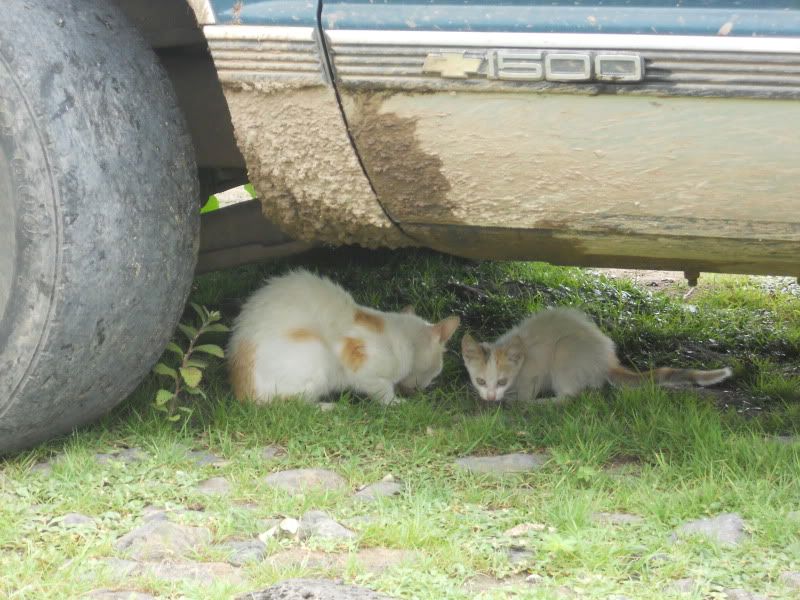
The cats, eating something they caught
At one point, I began talking to a little girl, about age 10, and she asked me if I would go with her to see the river. Oh yes, I told her. Would I jump in? she asked. I showed her my swimsuit that I brought with me. But before we could go to the river, everyone assembled into a group so we could hear one of Rosa's sons, a man I'll call Alfonso, tell us about his life.
Alfonso grows open-pollinated Mexican landrace corn, called maiz criollo here in Mexico. He says he does so because it tastes better, it's softer, it's better for tortillas, and he thinks it has more vitamins and it's better for human development (compared to hybrid and genetically engineered corn). He also likes that he can select the best seeds each year to plant the next year and thus improve the genetics of the corn he plants.
Alfonso tried growing hybrid corn once, in the 90's, but it was a failure. He told us it costs $1200 pesos (US$120) for a bag of hybrid seeds and then had to use fertilizer too. "It's really expensive at every stage of development," he said. "You have to put chemicals on it and it doesn't pay off." Now, in this part of Mexico, there's less maiz criollo but there's also less hybrid and transgenic corn. There's just less corn. When people switch to using hybrid and transgenic corn and their accompanying chemicals, they destroy their land. They can't switch back to maiz criollo and growing corn without chemicals. If you don't have enough money to keep buying the seeds and the chemicals, you can't produce corn.
Alfonso went to the California to work as a farmworker once, in 1988. He did it for a year and then hurt his foot. When his foot didn't heal with the antibiotics he got in the U.S., he came back to Mexico. His foot had a fungal infection and was nearly amputated, but a Mexican doctor was able to heal him. He missed his family while he was in the U.S. so he didn't go back. However, the money he earned there was enough to build an expansion on his home and to buy a truck. He laughed and told us that right now he doesn't even have the money to put gas in his truck. Later, we found out that he is now 32 years old. Someone did the math and realized that he went to work in the U.S. at age 12.

The truck he bought
To produce food and earn a living, Alfonso's family goes into the hills with bags on their backs from the end of each August until the next May to gather a wild tuber called camote. The children help with gathering camote. They are very careful to leave enough camote behind so that the plant will reproduce. Then they sell their camote in Cuquio for 3 pesos (US$.30) per kilo. If they are lucky, they sell 8 or 9 kilos of camote per day, earning their family 24-27 pesos ($2.40-$2.70) each day. This is the only way they have to earn money. There is no work in the rancho, and right now there is also no work in nearby towns like Cuquio.
In June, they stop collected camote and begin planting corn. This coincides with the start of the rainy season, which they rely on because they have no other form of irrigation. They use a horse and a plow to till their land and they weed by hand. (In other places, Mexican families use chemicals like 2,4-D, Roundup, and Paraquat on weeds.) They can harvest some corn early to eat as elotes (corn on the cob), but they mostly let the corn grow until December, when it is dry. Then they harvest it and grind it. In a good year, they have enough corn, beans, and squash to feed their family and their animals. In a bad year, they only produce enough to feed the animals. After the corn is harvested, they let cattle graze the land to feed on the crop residue and fertilize the land until the next time they plant. They vary the location where they plant their corn in order to produce more.
Most children here get an education only up to sixth grade. There is a secondary school and "la prepa" (high school) but it is expensive to pay for the uniforms and school supplies, and many families need their children to stay home and work. Alfonso looked at me and said that he wants his children to go to school, but what's the purpose of school if the child has an empty belly and can't learn? His first priority is making sure his children eat, so he needs them to work.
At last, we let the children lead us on a short hike to the river. Ann says that the area by the creek is one of the most biodiverse she's seen in the region. There are frogs and turtles in the creek, a sign that the area isn't too polluted with agrochemicals. (Later, one little boy caught a handful of tadpoles and brought them back to the village to show them off. Then he discarded them in a puddle the chickens were drinking from. One of the hens found the tadpoles and it looked like she was having the best day of her life.) At the creek, we saw cacti that would produce pitayas and tunas (two types of cactus fruit) for the villagers to eat when they were in season.
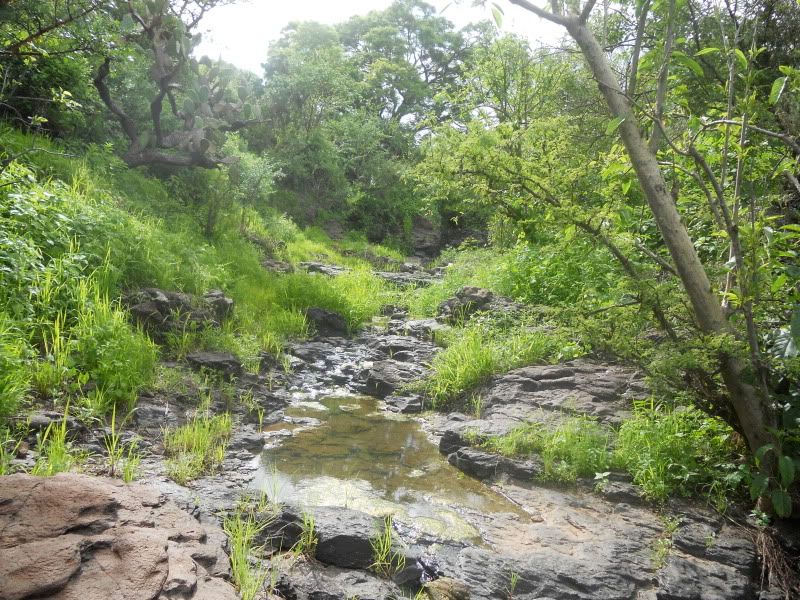
The creek where everyone bathes and gets their drinking water.
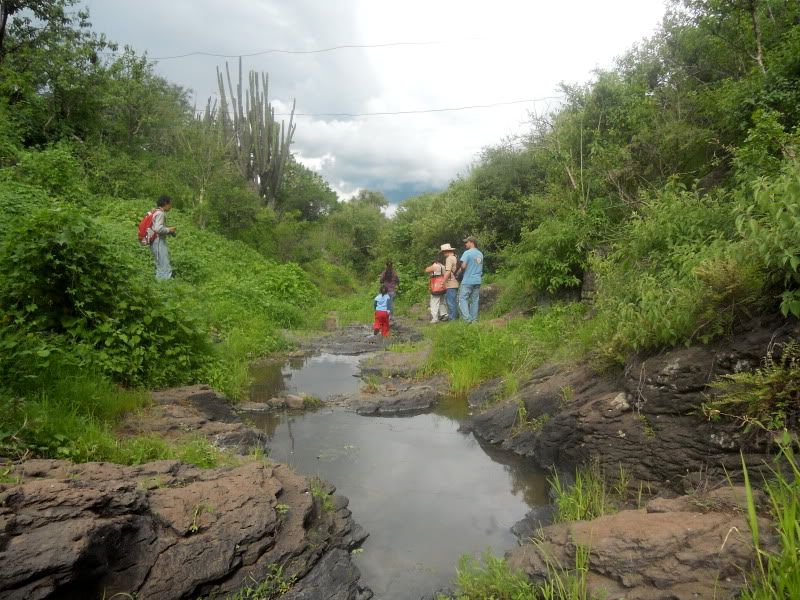
Another view of the creek
A few people wanted to hike all the way to a nearby waterfall, and the rest of us hung back and ate elotes cooked by a woman who lives across the street from Rosa. The child who wanted to know if I'd swim in the river saw money poking out of my purse and asked me about it. I told her it was for food. She led my by the hand to a nearby store. I was having a hard time understanding her Spanish but in retrospect, I assume she wanted me to buy her food. When I asked the kids what they ate each day, they told me they ate corn and beans for literally every meal, with perhaps some Nescafe coffee at lunch.
We went back to the store and found much of the group gathered there, drinking beers. Mostly the store sold processed food, but they had some fruit, nuts, juice, and a few other whole foods. Someone else on our trip had already told the kids to each pick out something healthy to drink (no Coca-Cola) and we would pay for it. After the kids got drinks, one girl pulled out some packaged junk food and asked if we'd pay for that too. Ann told her to go pick something healthy instead, so the girl got packages of nuts and distributed them among the children. (Later, Ann said, "Those kids were so hungry, if I kept buying them food they could have eaten all day.")
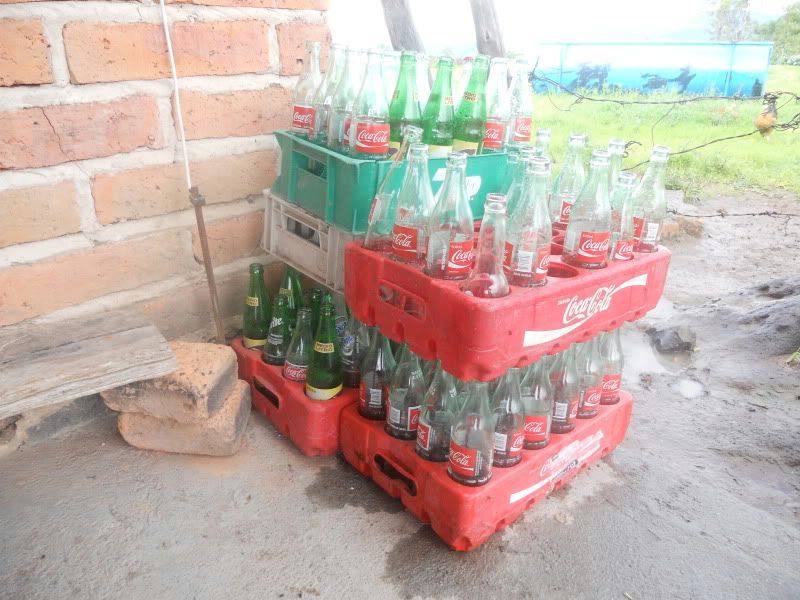
Empty Coke bottles outside the store. Talk about the wrong thing to drink in a country with a high rate of diabetes like Mexico.
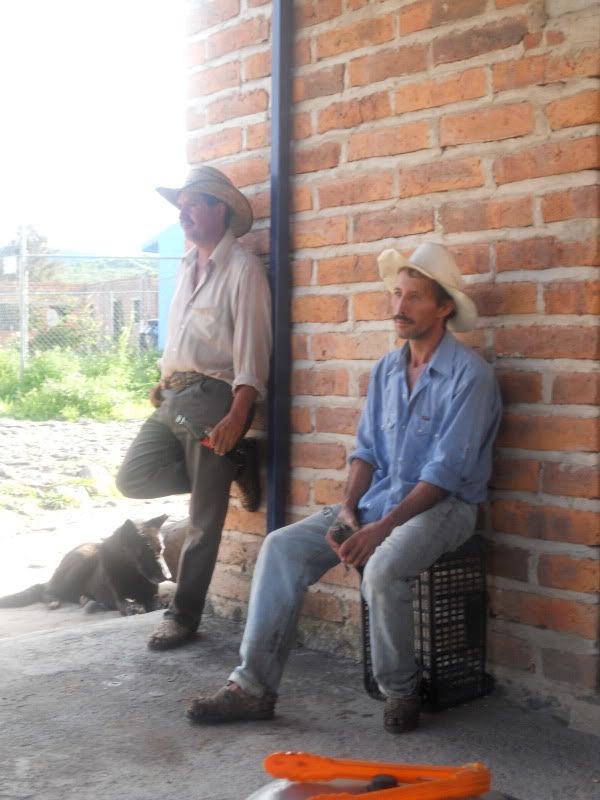
Men at the store, dressed like cowboys, drinking Cokes
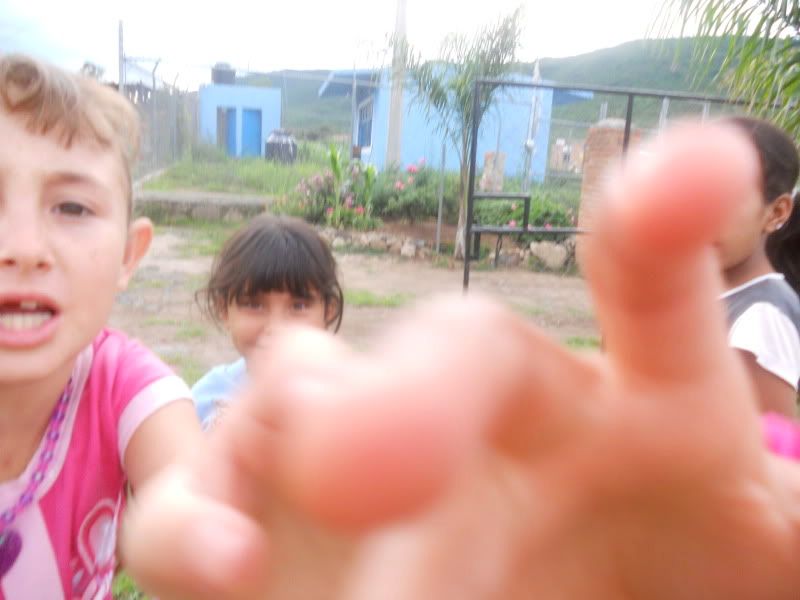
I let the kids play with my camera. They had a GREAT time with it, but I don't think they'd ever used a camera before and perhaps they'd never seen one. A bunch of photos like this were the result of their fun.
While we hung around the store, a Mexican man got stung by a scorpion. He was leaning against a wall, and the scorpion had made its home within the cracks in the wall. We had a nurse with us and asked her what to do about it. "Go to the hospital," she replied, jokingly. Obviously there was no hospital anywhere nearby. The people of the village told us they typically put bleach on scorpion bites, so that's what they did. Our nurse looked up information on scorpion bites on her iPhone and proceeded to make sure the man was okay. I assume her iPhone didn't recommend bleach. Someone else told me that the people of the village said they put bleach in their own drinking water to disinfect it.
At some point, several people headed over to the house where elotes were cooking for us. They served us the elotes with salt and lime. I wondered how much of a sacrifice it was for them, to serve us this corn. I spoke for a while with a man I'll call Roberto, the husband of the couple who lived there, and his wife, whose name I didn't learn. In addition to growing corn, squash, and beans, Roberto grew strawberries, cucumbers, chilis, basil, and calendula. He also had a number of fruit trees: lemon, lime, mandarin, orange, grapefruit, and guava. Judging from the size of his plants, it didn't appear that his soil was fantastic, although it was good enough that the plants could at least grow and produce something.
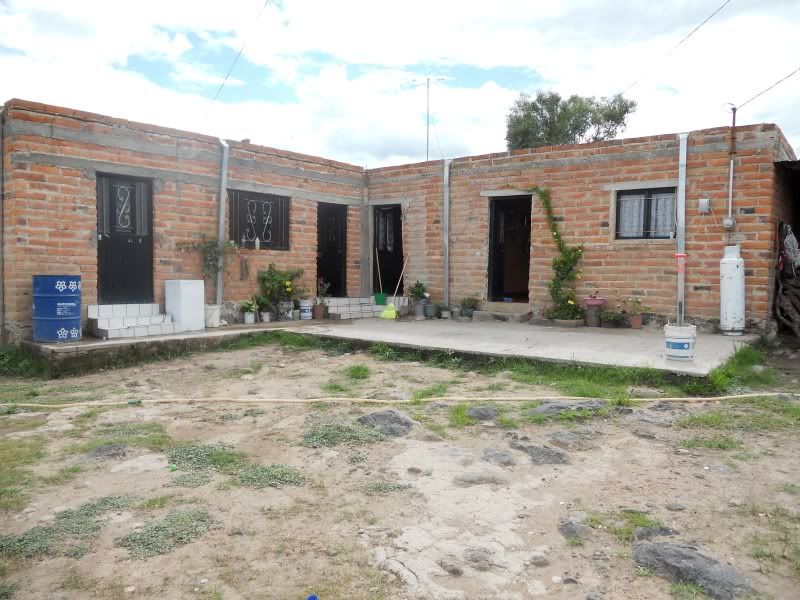
Roberto's house
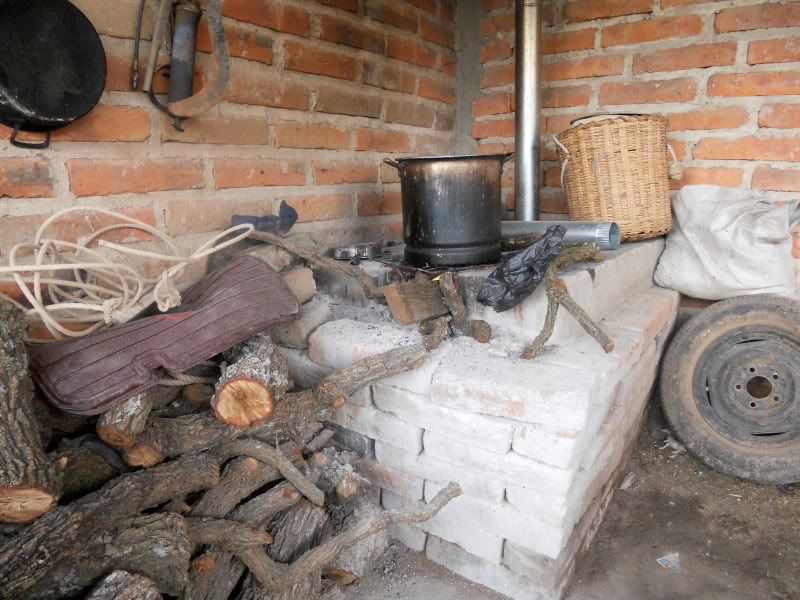
Cooking elotes
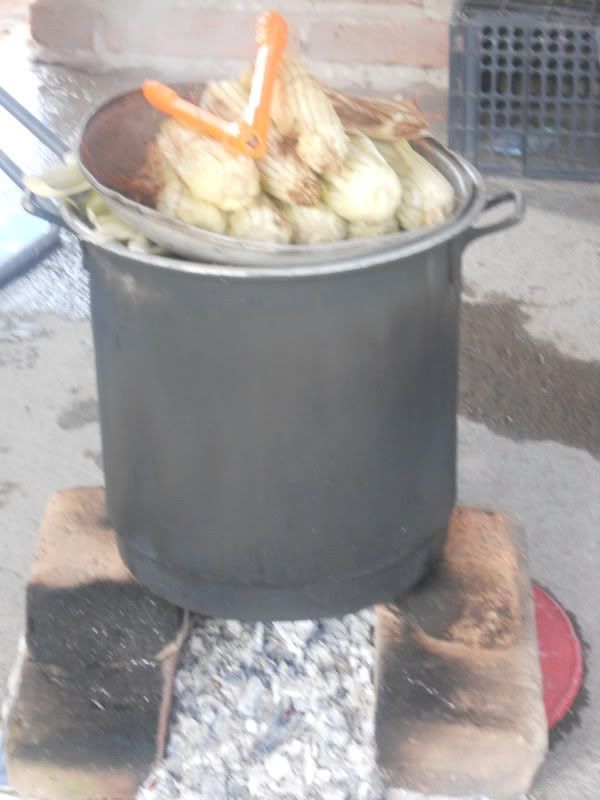
Mmm...elotes
On the way home, a member of our group asked if we noticed that none of the Mexicans wore glasses. He had noticed it on a previous trip and was told that a) they couldn't afford them b) the glasses broke quickly and c) nobody around here reads very much anyway. Someone else remarked that a common theme both here and in the U.S. is that the Mexican parents all want a better life for their children, and they want their children to be educated. However, on both sides of the border, it doesn't happen.
No comments:
Post a Comment